YAMAHA BT1100 2002 Service Manual
Manufacturer: YAMAHA, Model Year: 2002, Model line: BT1100, Model: YAMAHA BT1100 2002Pages: 96, PDF Size: 3.32 MB
Page 41 of 96
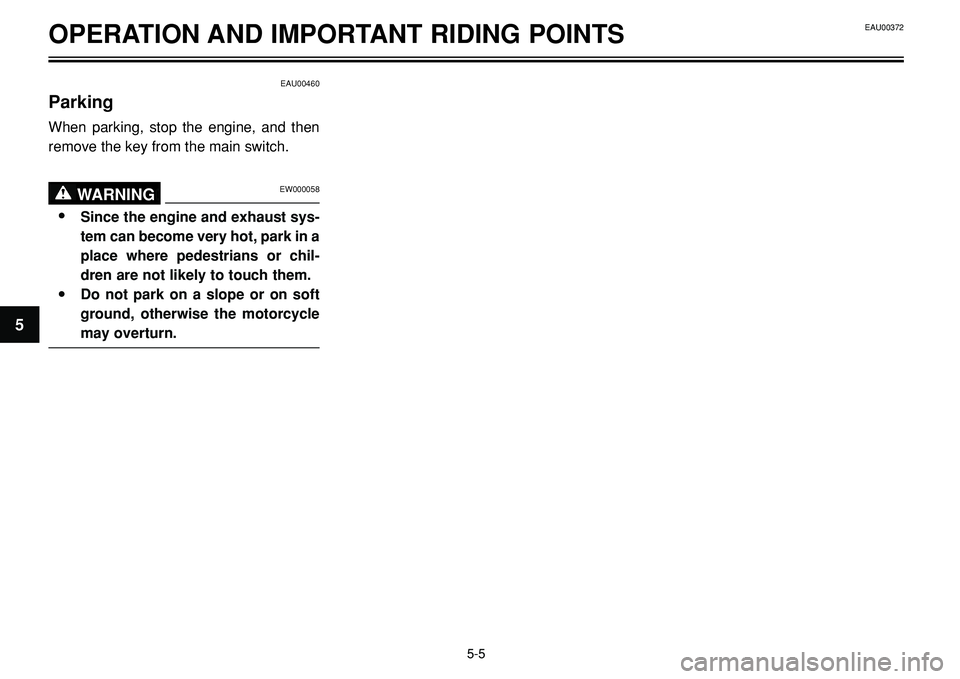
OPERATION AND IMPORTANT RIDING POINTS
EAU00460
Parking
When parking, stop the engine, and then
remove the key from the main switch.
EW000058WARNING0
•Since the engine and exhaust sys-
tem can become very hot, park in a
place where pedestrians or chil-
dren are not likely to touch them.
•Do not park on a slope or on soft
ground, otherwise the motorcycle
may overturn.
5-5
5
EAU00372
Page 42 of 96
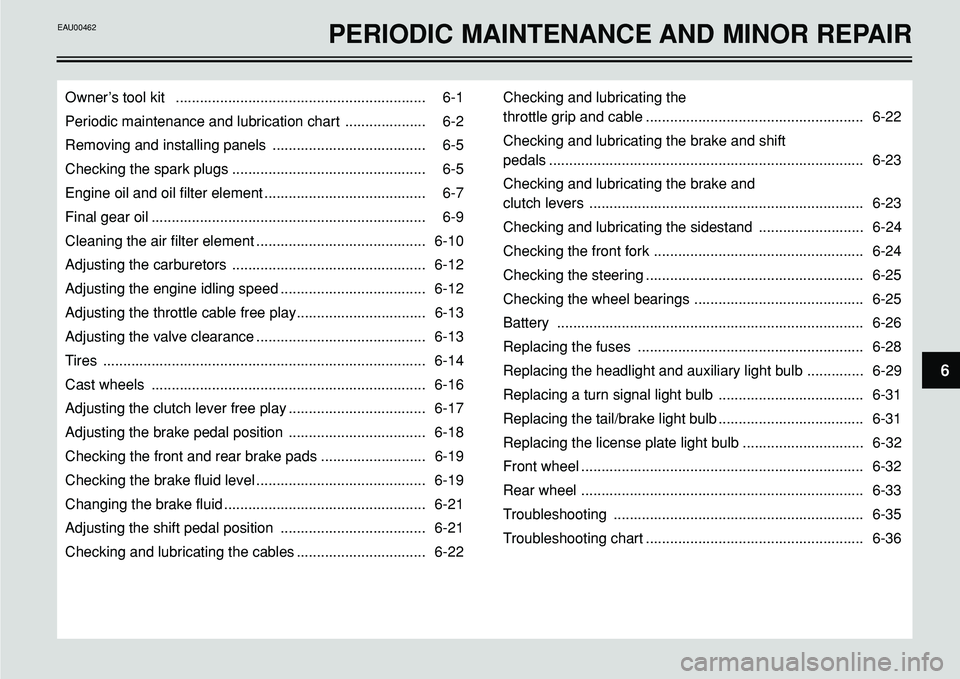
6
Owner’s tool kit .............................................................. 6-1
Periodic maintenance and lubrication chart .................... 6-2
Removing and installing panels ...................................... 6-5
Checking the spark plugs ................................................ 6-5
Engine oil and oil filter element ........................................ 6-7
Final gear oil .................................................................... 6-9
Cleaning the air filter element .......................................... 6-10
Adjusting the carburetors ................................................ 6-12
Adjusting the engine idling speed .................................... 6-12
Adjusting the throttle cable free play................................ 6-13
Adjusting the valve clearance .......................................... 6-13
Tires ................................................................................ 6-14
Cast wheels .................................................................... 6-16
Adjusting the clutch lever free play .................................. 6-17
Adjusting the brake pedal position .................................. 6-18
Checking the front and rear brake pads .......................... 6-19
Checking the brake fluid level .......................................... 6-19
Changing the brake fluid .................................................. 6-21
Adjusting the shift pedal position .................................... 6-21
Checking and lubricating the cables ................................ 6-22Checking and lubricating the
throttle grip and cable ...................................................... 6-22
Checking and lubricating the brake and shift
pedals .............................................................................. 6-23
Checking and lubricating the brake and
clutch levers .................................................................... 6-23
Checking and lubricating the sidestand .......................... 6-24
Checking the front fork .................................................... 6-24
Checking the steering ...................................................... 6-25
Checking the wheel bearings .......................................... 6-25
Battery ............................................................................ 6-26
Replacing the fuses ........................................................ 6-28
Replacing the headlight and auxiliary light bulb .............. 6-29
Replacing a turn signal light bulb .................................... 6-31
Replacing the tail/brake light bulb .................................... 6-31
Replacing the license plate light bulb .............................. 6-32
Front wheel ...................................................................... 6-32
Rear wheel ...................................................................... 6-33
Troubleshooting .............................................................. 6-35
Troubleshooting chart ...................................................... 6-36
PERIODIC MAINTENANCE AND MINOR REPAIREAU00462
Page 43 of 96
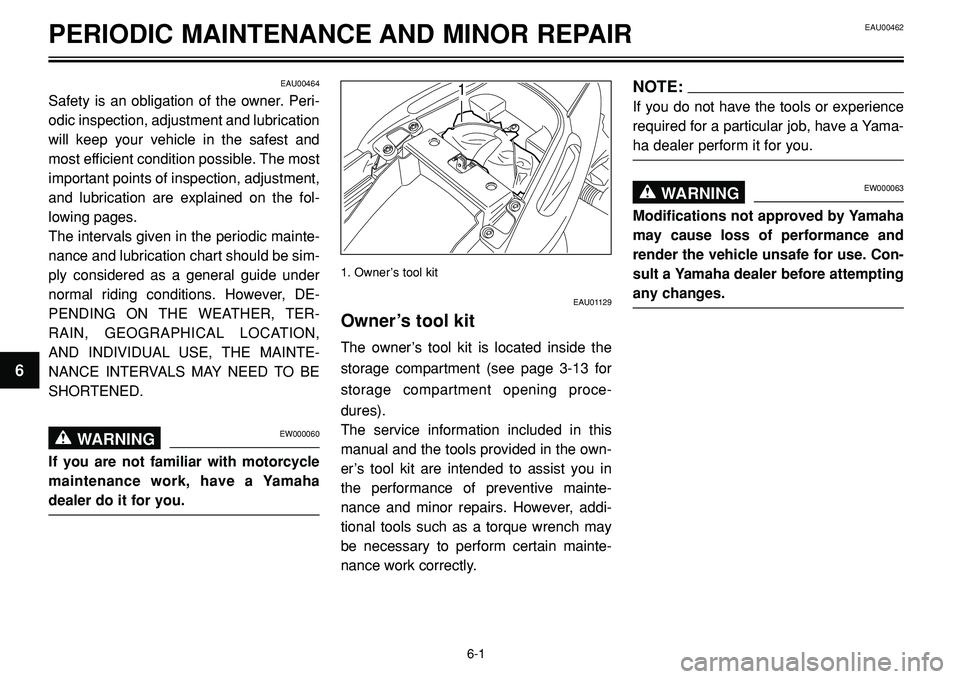
EAU00462PERIODIC MAINTENANCE AND MINOR REPAIR
1EAU00464
Safety is an obligation of the owner. Peri-
odic inspection, adjustment and lubrication
will keep your vehicle in the safest and
most efficient condition possible. The most
important points of inspection, adjustment,
and lubrication are explained on the fol-
lowing pages.
The intervals given in the periodic mainte-
nance and lubrication chart should be sim-
ply considered as a general guide under
normal riding conditions. However, DE-
PENDING ON THE WEATHER, TER-
RAIN, GEOGRAPHICAL LOCATION,
AND INDIVIDUAL USE, THE MAINTE-
NANCE INTERVALS MAY NEED TO BE
SHORTENED.
EW000060WARNING0
If you are not familiar with motorcycle
maintenance work, have a Yamaha
dealer do it for you.
1. Owner’s tool kit
EAU01129
Owner’s tool kit
The owner’s tool kit is located inside the
storage compartment (see page 3-13 for
storage compartment opening proce-
dures).
The service information included in this
manual and the tools provided in the own-
er’s tool kit are intended to assist you in
the performance of preventive mainte-
nance and minor repairs. However, addi-
tional tools such as a torque wrench may
be necessary to perform certain mainte-
nance work correctly.
NOTE:
If you do not have the tools or experience
required for a particular job, have a Yama-
ha dealer perform it for you.
EW000063WARNING0
Modifications not approved by Yamaha
may cause loss of performance and
render the vehicle unsafe for use. Con-
sult a Yamaha dealer before attempting
any changes.
6-1
6
Page 44 of 96
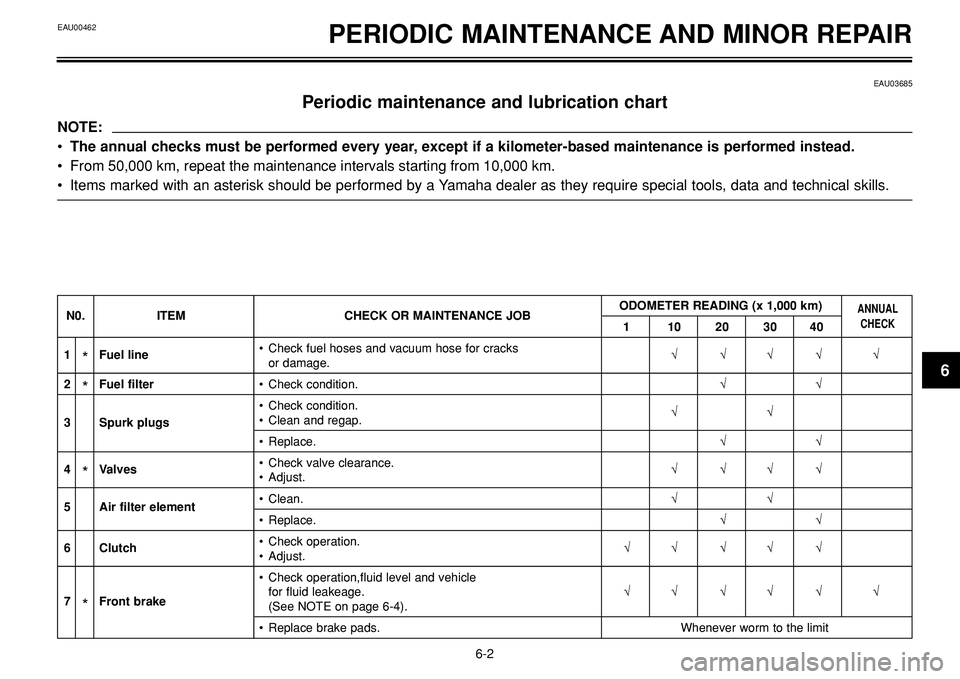
EAU00462PERIODIC MAINTENANCE AND MINOR REPAIR
EAU03685
Periodic maintenance and lubrication chart
NOTE:
•The annual checks must be performed every year, except if a kilometer-based maintenance is performed instead.
•From 50,000 km, repeat the maintenance intervals starting from 10,000 km.
•Items marked with an asterisk should be performed by a Yamaha dealer as they require special tools, data and technical skills.
6-2
6
ODOMETER READING (x 1,000 km)ANNUALN0. ITEM CHECK OR MAINTENANCE JOB
1 10203040CHECK
1*Fuel line•Check fuel hoses and vacuum hose for cracks
√√√√ √or damage.
2*Fuel filter•Check condition.√√
•Check condition.
√√
3 Spurk plugs•Clean and regap.
•Replace.√√
4
*Valves•Check valve clearance.
√√√√•Adjust.
5 Air filter element•Clean.√√•Replace.√√
6 Clutch•Check operation.
√√ √√ √
•Adjust.
•Check operation,fluid level and vehicle
for fluid leakeage. √√ √√ √ √
7*Front brake
(See NOTE on page 6-4).
•Replace brake pads. Whenever worm to the limit
Page 45 of 96
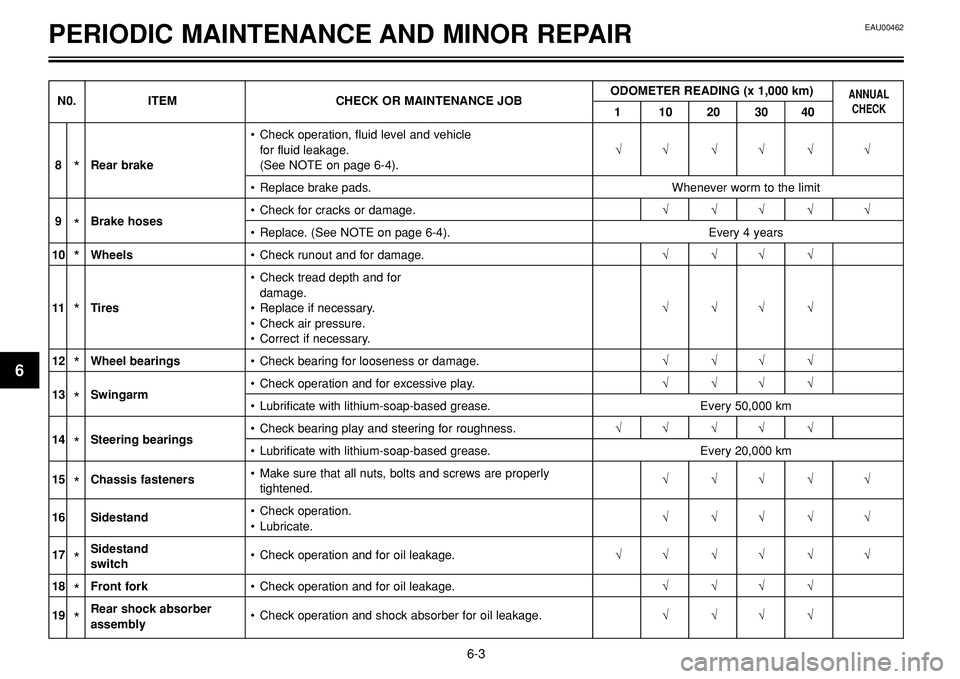
EAU00462
ODOMETER READING (x 1,000 km)ANNUALN0. ITEM CHECK OR MAINTENANCE JOB
1 10203040CHECK
•Check operation, fluid level and vehicle
for fluid leakage. √√ √√ √ √
8*Rear brake(See NOTE on page 6-4).
•Replace brake pads. Whenever worm to the limit
9*Brake hoses•Check for cracks or damage.√√√√ √•Replace. (See NOTE on page 6-4). Every 4 years
10*Wheels•Check runout and for damage.√√√√
•Check tread depth and for
damage.
11
*Tires•Replace if necessary.√√√√
•Check air pressure.
•Correct if necessary.
12*Wheel bearings•Check bearing for looseness or damage.√√√√
13*Swingarm•Check operation and for excessive play.√√√√•Lubrificate with lithium-soap-based grease. Every 50,000 km
14*Steering bearings•Check bearing play and steering for roughness.√√ √√ √•Lubrificate with lithium-soap-based grease. Every 20,000 km
15
*Chassis fasteners•Make sure that all nuts, bolts and screws are properly
√√√√ √tightened.
16 Sidestand•Check operation.
√√√√ √
•Lubricate.
17
*Sidestand
•Check operation and for oil leakage.√√ √√ √ √switch
18*Front fork•Check operation and for oil leakage. √√√√
19
*Rear shock absorber
•Check operation and shock absorber for oil leakage.√√√√
assembly
PERIODIC MAINTENANCE AND MINOR REPAIR
6-3
6
Page 46 of 96
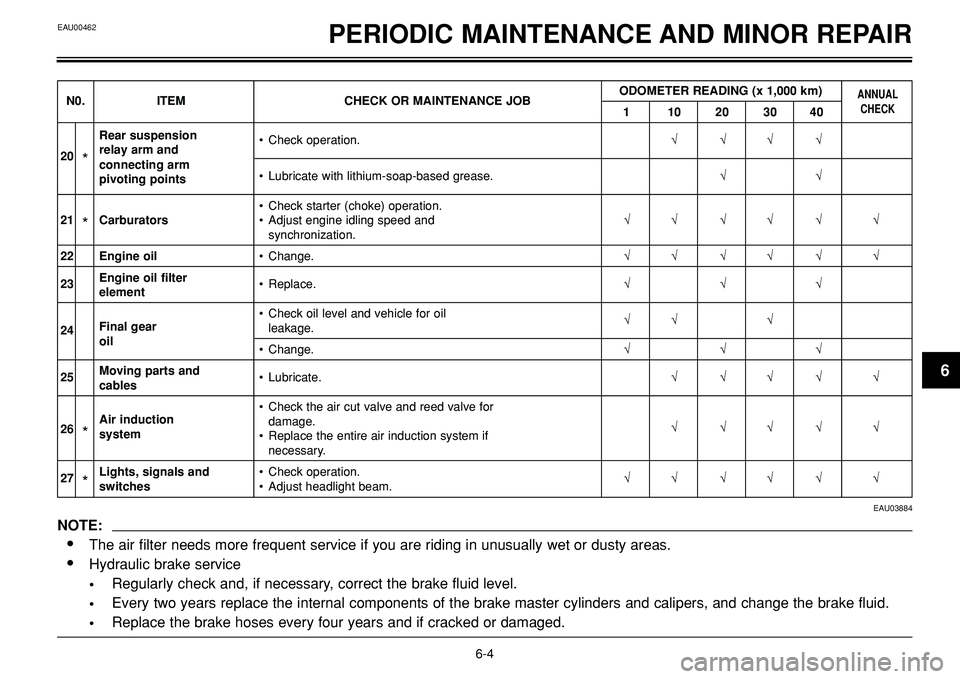
EAU00462PERIODIC MAINTENANCE AND MINOR REPAIR
EAU03884
NOTE:
•The air filter needs more frequent service if you are riding in unusually wet or dusty areas.
•Hydraulic brake service
•Regularly check and, if necessary, correct the brake fluid level.
•Every two years replace the internal components of the brake master cylinders and calipers, and change the brake fluid.
•Replace the brake hoses every four years and if cracked or damaged.
6-4
6
ODOMETER READING (x 1,000 km)ANNUALN0. ITEM CHECK OR MAINTENANCE JOB
1 10203040CHECK
Rear suspension
•Check operation. √√√√
20*relay arm and
connecting arm
•Lubricate with lithium-soap-based grease.√√
pivoting points
•Check starter (choke) operation.
21
*Carburators•Adjust engine idling speed and √√ √√ √ √synchronization.
22 Engine oil•Change.√√ √√ √ √
23Engine oil filter
•Replace. √√√
element
•Check oil level and vehicle for oil
√√ √
24Final gear
leakage.oil
•Change.√√√
25Moving parts and
•Lubricate.√√√√ √
cables
•Check the air cut valve and reed valve for
26
*Air induction
damage.
√√√√ √
system
•Replace the entire air induction system if
necessary.
27
*Lights, signals and •Check operation.
√√ √√ √ √
switches•Adjust headlight beam.
Page 47 of 96
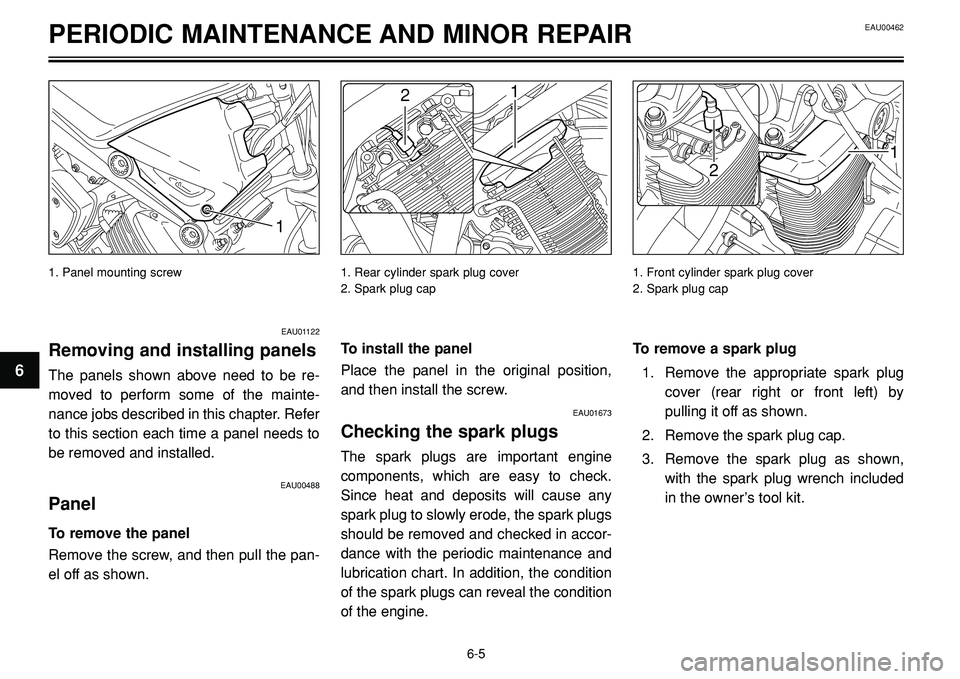
EAU00462PERIODIC MAINTENANCE AND MINOR REPAIR
12
1
2
1. Rear cylinder spark plug cover
2. Spark plug cap1. Front cylinder spark plug cover
2. Spark plug cap
To install the panel
Place the panel in the original position,
and then install the screw.
EAU01673
Checking the spark plugs
The spark plugs are important engine
components, which are easy to check.
Since heat and deposits will cause any
spark plug to slowly erode, the spark plugs
should be removed and checked in accor-
dance with the periodic maintenance and
lubrication chart. In addition, the condition
of the spark plugs can reveal the condition
of the engine.
EAU01122
Removing and installing panels
The panels shown above need to be re-
moved to perform some of the mainte-
nance jobs described in this chapter. Refer
to this section each time a panel needs to
be removed and installed.
EAU00488
Panel
To remove the panel
Remove the screw, and then pull the pan-
el off as shown. To remove a spark plug
1. Remove the appropriate spark plug
cover (rear right or front left) by
pulling it off as shown.
2. Remove the spark plug cap.
3. Remove the spark plug as shown,
with the spark plug wrench included
in the owner’s tool kit.
6-5
6
1
1. Panel mounting screw
Page 48 of 96
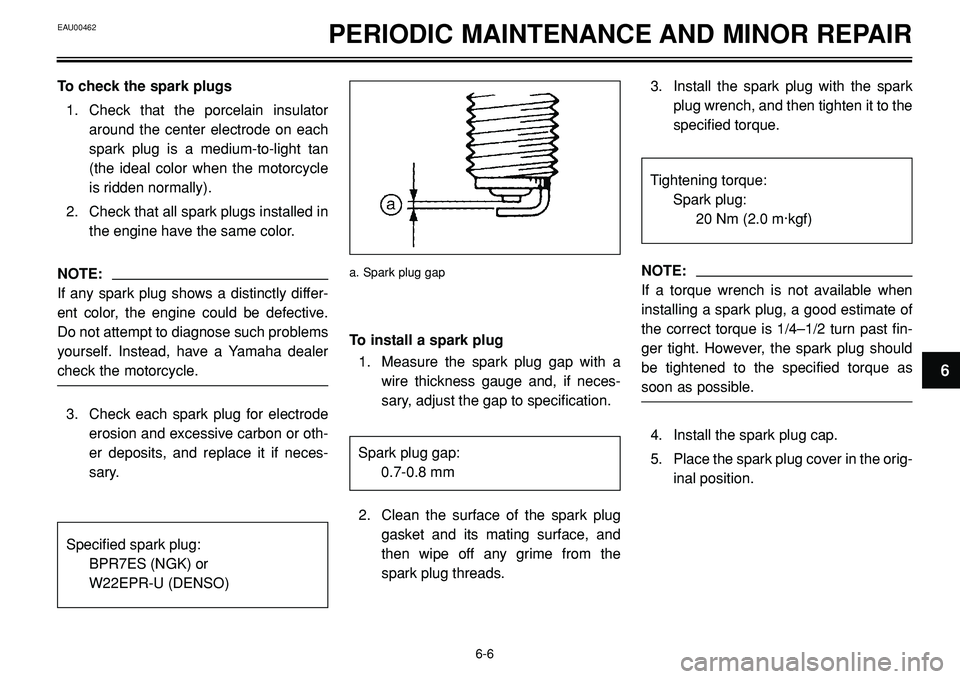
EAU00462PERIODIC MAINTENANCE AND MINOR REPAIR
To install a spark plug
1. Measure the spark plug gap with a
wire thickness gauge and, if neces-
sary, adjust the gap to specification.
2. Clean the surface of the spark plug
gasket and its mating surface, and
then wipe off any grime from the
spark plug threads.3. Install the spark plug with the spark
plug wrench, and then tighten it to the
specified torque.
NOTE:
If a torque wrench is not available when
installing a spark plug, a good estimate of
the correct torque is 1/4–1/2 turn past fin-
ger tight. However, the spark plug should
be tightened to the specified torque as
soon as possible.
4. Install the spark plug cap.
5. Place the spark plug cover in the orig-
inal position.
6-6
6
a. Spark plug gap
To check the spark plugs
1. Check that the porcelain insulator
around the center electrode on each
spark plug is a medium-to-light tan
(the ideal color when the motorcycle
is ridden normally).
2. Check that all spark plugs installed in
the engine have the same color.
NOTE:
If any spark plug shows a distinctly differ-
ent color, the engine could be defective.
Do not attempt to diagnose such problems
yourself. Instead, have a Yamaha dealer
check the motorcycle.
3. Check each spark plug for electrode
erosion and excessive carbon or oth-
er deposits, and replace it if neces-
sary.
Specified spark plug:
BPR7ES (NGK) or
W22EPR-U (DENSO)
Tightening torque:
Spark plug:
20 Nm (2.0 m·kgf)
Spark plug gap:
0.7-0.8 mm
Page 49 of 96
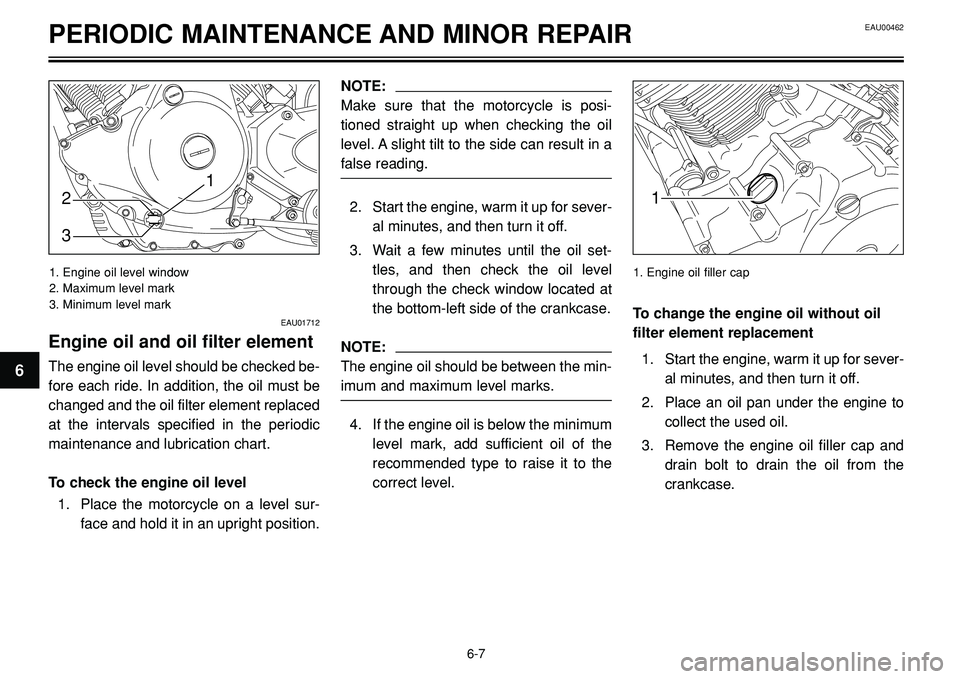
EAU00462
1. Engine oil filler cap
PERIODIC MAINTENANCE AND MINOR REPAIR
1
NOTE:
Make sure that the motorcycle is posi-
tioned straight up when checking the oil
level. A slight tilt to the side can result in a
false reading.
2. Start the engine, warm it up for sever-
al minutes, and then turn it off.
3. Wait a few minutes until the oil set-
tles, and then check the oil level
through the check window located at
the bottom-left side of the crankcase.
NOTE:
The engine oil should be between the min-
imum and maximum level marks.
4. If the engine oil is below the minimum
level mark, add sufficient oil of the
recommended type to raise it to the
correct level.To change the engine oil without oil
filter element replacement
1. Start the engine, warm it up for sever-
al minutes, and then turn it off.
2. Place an oil pan under the engine to
collect the used oil.
3. Remove the engine oil filler cap and
drain bolt to drain the oil from the
crankcase.
6-7
6
2
31
EAU01712
Engine oil and oil filter element
The engine oil level should be checked be-
fore each ride. In addition, the oil must be
changed and the oil filter element replaced
at the intervals specified in the periodic
maintenance and lubrication chart.
To check the engine oil level
1. Place the motorcycle on a level sur-
face and hold it in an upright position.
1. Engine oil level window
2. Maximum level mark
3. Minimum level mark
Page 50 of 96
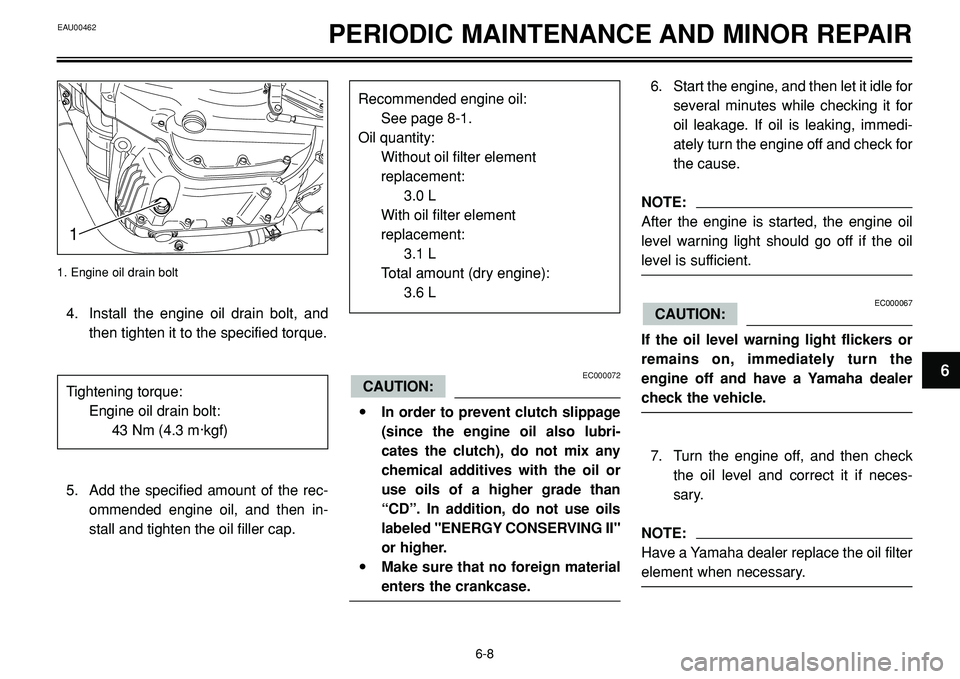
EAU00462PERIODIC MAINTENANCE AND MINOR REPAIR
EC000072
•In order to prevent clutch slippage
(since the engine oil also lubri-
cates the clutch), do not mix any
chemical additives with the oil or
use oils of a higher grade than
“CD”. In addition, do not use oils
labeled "ENERGY CONSERVING II"
or higher.
•Make sure that no foreign material
enters the crankcase.
CAUTION:6. Start the engine, and then let it idle for
several minutes while checking it for
oil leakage. If oil is leaking, immedi-
ately turn the engine off and check for
the cause.
NOTE:
After the engine is started, the engine oil
level warning light should go off if the oil
level is sufficient.
EC000067
If the oil level warning light flickers or
remains on, immediately turn the
engine off and have a Yamaha dealer
check the vehicle.
7. Turn the engine off, and then check
the oil level and correct it if neces-
sary.
NOTE:
Have a Yamaha dealer replace the oil filter
element when necessary.
CAUTION:
1. Engine oil drain bolt
6-8
6
1
4. Install the engine oil drain bolt, and
then tighten it to the specified torque.
5. Add the specified amount of the rec-
ommended engine oil, and then in-
stall and tighten the oil filler cap. Tightening torque:
Engine oil drain bolt:
43 Nm (4.3 m·kgf)
Recommended engine oil:
See page 8-1.
Oil quantity:
Without oil filter element
replacement:
3.0 L
With oil filter element
replacement:
3.1 L
Total amount (dry engine):
3.6 L